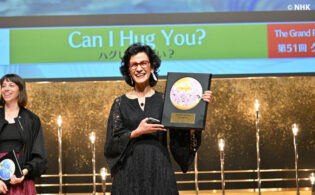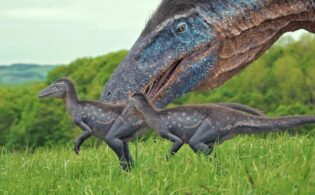The Great Kanto Earthquake that struck Japan in 1923 laid bare the need for a nationwide information system to keep citizens safe. Two years later, stations in three cities—Tokyo, Osaka and Nagoya—began the country’s first radio broadcasts and, a year later, would come together to form the first incarnation of NHK. The country’s public-service broadcaster has transformed with the times, but its remit to serve its citizens with trustworthy, reliable information remains at the heart of the organization, Nobuo Inaba, its president, tells World Screen. Internationally, NHK is delivering its content via the channel NHK WORLD-JAPAN, while NHK Enterprises is bringing a diverse slate of drama, documentaries, entertainment and kids’ fare to broadcasters and platforms worldwide. Driving gains at its commercial arm and bolstering co-productions are key mandates for the pubcaster as it navigates an evolving ecosystem, alongside continued R&D into elevating the viewing experience, all while retaining the trust of audiences.
WS: Tell us about NHK’s positioning today as it marks 100 years of broadcasting in Japan.
INABA: On March 22, 1925, 100 years ago, the first radio broadcast came out in Japan. NHK did not exist at the time—the first broadcast was conducted by stations in Tokyo, Osaka and Nagoya. These three stations were unified the following year to become NHK. The broadcast that started in 1925 had a significant impact on the development of Japanese society. The need for a broadcast system was compelled by the Great Kanto Earthquake in 1923. At the time, people were not able to get the necessary information, and there were a lot of rumors spreading, causing social confusion. These circumstances led to a decision to establish a broadcaster in order to spread reliable, accurate information and protect the lives of people.
Since the start, to this day, be it earthquakes or tsunamis, political, economic or social issues, NHK has prioritized transmitting accurate and reliable information and has continued to stand by the people in times of turbulence while documenting the Japanese people’s resilience. This role and position in society as a public broadcaster has not changed since its start and will continue. As we stand at the starting point of the next 100 years, NHK will strive to transmit accurate and fair information while offering a variety of content that will enrich people’s lives.
WS: How have you progressed in your three-year plan for NHK? Where are you on the key strategic initiatives you set when taking on the position, and what shifts have you made given the evolving media landscape?
INABA: One big evolution is regarding NHK’s activities in the internet space. In May last year, the Japanese Broadcasting Act was revised, making NHK’s internet operations an imperative duty, enabling NHK to better meet the demands of the audience. As of October this year, NHK will be able to offer via the internet the same value of what we offer through broadcasting. This is a historic moment for NHK. The reliable information and rich content currently being offered to our audience mainly on broadcast will be accessible through the internet, thereby further enriching the lives of people.
At the same time, our responsibility as a public-service media organization becomes even heavier. As the internet space is more susceptible to what is known as the attention economy, there is a greater possibility for misinformation, disinformation and sensational, negative content to stand out, and this can lead to the creation of a biased information space. Our mandate is to continue to provide reliable and accurate information in the hope of serving as a reference point for the people, and this mandate is becoming more important than ever.
And now that the world is becoming even more polarized with so much social confusion going on, it is important that we join hands with our partners around the world and work together, not only to tackle disinformation and misinformation, but to also find ways to enhance dialogue and mutual understanding.
WS: What are some of your key programming initiatives for 2025, especially as it relates to the milestone anniversary of Japanese broadcasting?
INABA: We will be airing many programs to celebrate the centennial throughout the year on all channels. One key initiative is the annual period drama (the Taiga drama) that has continued since 1963. Each year, the life story of a historical figure is depicted through 50 episodes, covering everything from epic samurai battles to Japan’s era of rapid modernization. Over the years, the Taiga dramas have featured some of Japan’s most celebrated actors, including Ken Watanabe, Hiroyuki Sanada and Toshiro Mifune.
Last year’s Taiga drama was Dear Radiance, which depicted the life of Murasaki Shikibu, the author of The Tale of Genji, considered to be the world’s oldest novel by a female writer. The drama brought in a fresh breeze and succeeded in attracting new viewers. This year’s 64th installment is Unbound, which depicts the life of Tsutaya Juzaburo, the “King of Media” of the Edo era. Set in the 18th century, this is the story about a man who was the driving force behind Japan’s cultural renaissance, discovering world-renowned ukiyo-e artists like Sharaku, Utamaro and Hokusai. Starting his career from his humble book rental shop, he progresses to set up a publishing house, where he delivers one hit after another. It is an epic tale that chronicles the life of a man who blossomed Japanese culture, laid the foundations of Japan’s media industry and pop culture and relentlessly pursued beauty and freedom. This entertainment drama is the perfect tribute to mark the centennial of broadcasting.
We plan to air a documentary series, currently in production, called Neo-Japonism (w.t.). Japanese manga, anime, J-pop, cuisine and traditional crafts have garnered widespread popularity across the globe. This series will explore the vibrant movements surrounding Japanese culture worldwide, capturing interactions with local people and cultures. It will also delve into Japan’s history to uncover the roots of the culture that captivates the 21st-century world. I believe it is a series that offers global audiences an opportunity to reflect on culture and society through the lens of Japanese culture.
WS: How have you invested in new technologies to ensure you continue to entertain and educate Japanese audiences and serve them across platforms?
INABA: A good example is our coverage of natural disasters, which is one of our important missions rooted in the origins of NHK. We have continued to upgrade our equipment and facilities and reinforce our coverage system to offer vital information to help save people’s lives. To quickly convey the situation in disaster-stricken areas, NHK has installed 850 robot cameras and 15 helicopters throughout Japan. During the Great East Japan Earthquake in 2011, NHK put these to full use to provide live coverage of the tsunami situation as it unfolded.
Furthermore, we are incorporating the latest innovations into our disaster reporting. In the series Disaster Big Data, which was produced after the Great East Japan Earthquake, we utilized various sources, such as the movement of hundreds of thousands of people in the disaster-stricken areas, driving records from car navigation systems and 180 million social media posts sent out in the first week after the disaster, uncovering the full picture of how people reacted that day. Programs like these will offer people lessons for survival in the future when new major disasters occur and are also important for disaster prevention and mitigation.
Over the years, our investment in broadcast technology has enriched other aspects of our content production. NHK is a pioneer of HD and was the first to launch an 8K channel. We have always striven to incorporate new technology for new styles of visual expression. For example, in 2012, NHK, NHK Enterprises and the U.S.-based Discovery Channel succeeded in capturing the world’s first-ever video images of a giant squid in its natural deep-ocean habitat. We developed a special ultra-sensitive high-definition camera to enable operation at great depths. The camera used a special light with a specific wavelength invisible to the sensitive giant squid eye. Culminating ten years of research with the National Museum of Nature and Science of Japan, the project succeeded and brought us messages of how global warming was reaching even the deep sea.
The “Deep Ocean” team, which is known for its success in capturing on film the giant squid, has succeeded in filming another world first. This time, in collaboration with ZDF, ARTE and OceanX, the team headed to the sea of Indonesia in hopes of unraveling the ecology of the mysterious and ancient phantom fish, the coelacanth. NHK’s research and planning for the filming started six years ago. The project developed a special ultra-high-sensitive 8K deep-sea filming system, and by collaborating with scientists from around the world, they conducted the world’s first 72-hour consecutive filming expedition. They were able to capture a school of coelacanths hiding under a steep cliff. Coelacanths are considered to be a solitary species, and previous observations had not revealed any behaviors indicating awareness of other individuals. However, in this expedition, the team was able to document numerous instances of interactions between coelacanths, suggesting a connection to reproductive activities. This is the first time in the world that footage of coelacanth behavior possibly linked to reproduction was filmed, and it marks a significant step forward in understanding the behavior of these ancient fish. Footage will be shown in Deep Ocean: The Kingdom of the Coelacanth, a co-production with ZDF, ARTE and OceanX, in collaboration with the Coordinating Ministry of Maritime Affairs and Investment (CMMAI) of Indonesia.
WS: How are you positioning your commercial arm, NHK Enterprises, and where do you hope to see gains in the year ahead?
INABA: I have high expectations for NHK Enterprises and our other affiliate companies for their potential of diverse activities that go beyond NHK’s remit as a public broadcaster. As commercial entities, NHK’s affiliates can be more flexible in collaborating with other private companies.
Last fall, I heard from NHK Enterprises that a special program from the “Professionals” series, Hayao Miyazaki and the Heron, was released in theaters in Taiwan, Italy, France and more. This is a two-hour documentary that chronicles the making of the Oscar-winning The Boy and the Heron, filmed with exclusive access to Studio Ghibli across seven years. Additionally, some of our popular dramas were distributed on global platforms. For example, Shrink: Psychiatrist Yowai is a heartwarming drama based on a manga series of the same title. Another is The Science Club, a drama about a mysterious science teacher and his students at a night high school with vastly varied backgrounds. Inspired by a true story, the class works to re-create a “Martian crater” to present at an academic conference. NHK Enterprises’ role is important in sharing NHK content with the world, transcending country borders and media.
Japan has produced great filmmakers and visual creators such as Yasujiro Ozu, Akira Kurosawa and Osamu Tezuka. Being a group of content creators, NHK values the rich cinematic heritage built by these predecessors and continues to produce content with deep respect for this tradition. In recent years, we are seeing a growing appetite for diverse voices and local storytelling, and I hope that NHK will continue to create quality programs that resonate with audiences worldwide.
WS: How important are co-pros and other international collaborations for NHK?
INABA: International co-productions are very important for NHK for several reasons. The greatest benefit is that we are able to bring together budgets, talent and resources to create impactful programs. This is becoming ever more important in an age when public media around the world is facing budget constraints. Viewer expectations for grand-scale programming remain high, and NHK is always looking for new styles of storytelling and event programs with new discoveries and big impacts on a global scale.
Also, co-production is becoming vitally important in tackling global issues. Now, as the world is becoming so polarized and divided, it is becoming more difficult for one country or region alone to solve problems that affect all of us, such as climate change and global conflict. It is all the more important that like-minded broadcasters and media companies around the world join hands to look for seeds of resolution. That is one of the reasons why NHK has joined Global Doc, an initiative led by France Télévisions where public media companies join forces to support and co-finance ambitious documentary projects with universal appeal.
As the media industry becomes more diverse and fragmented, we believe that these partnerships play an important role in making sure that aspiring filmmakers are supported and that well-researched, high-quality content is made and delivered to the public. One example is Snowman Race, which will follow the world’s toughest trail race, covering [about] 186 kilometers of mountainous terrain in the Bhutanese Himalayas over four nights and five days. NHK, in collaboration with Bhutan’s national broadcaster BBS, was the first broadcaster in the world to provide exclusive and complete coverage of this extraordinary race. This program, set against the mystical grandeur of the Himalayas, will portray the aspirations and endeavors of runners while conveying the stark realities of climate change through their eyes. Hidden Japan is a two-part series depicting nature from the uniquely Japanese perspective called “en,” a word often translated as “connection” or “relationship” in English, but it carries a deeper, more nuanced meaning: the bonds or fateful connection between people. The first episode is set in ancient Japanese cities such as Kyoto and Nara. The second is set in the forests that gave birth to nature worship. It depicts the intimate relationship between humans and the creatures nourished by the forests. The film has attracted a great deal of interest from overseas producers from the development stage and will be co-produced internationally with European producers.
WS: What are some of your other key strategic goals and initiatives for NHK in the 12 to 18 months ahead?
INABA: For the past 100 years of broadcasting, NHK has continued to offer a diverse array of programs that have enriched the lives and hearts of people. In October this year, integrating our internet operations to offer values equal to what we offer on our broadcasting services is an important step for NHK. The mission and responsibility to provide accurate and reliable information, as well as diverse content that enriches people’s lives, not only through broadcasting but also tailored to the unique characteristics of the internet, will become heavier. We aim to ensure the integrity of the information space, including the internet, and aspire to contribute to the advancement of democracy in Japan and around the world.
2025 also coincides with the 80th [anniversary of the end of] WWII. With a focus on youth, we aim to examine war and peace within the context of the contemporary world. One of these initiatives is the creation of anime content that resonates with many generations. cocoon is a new anime based on the manga of the same title by Machiko Kyo. It will delicately portray the war through the eyes of a girl living on an island and will be produced by former Studio Ghibli animation producer Hitomi Tateno. Bringing together the talents of both young and veteran animators, the project aims to deliver a film that inspires people of all generations to reflect on and rethink the concept of war.






